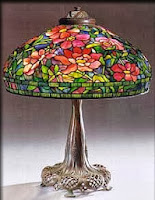Favrile Glass Lamps
Tiffany trademarked the name "Favrile" to generically describe his production. The term means handcrafted and is associated with the first and simplest shades made by Tiffany. Favrile glass included several types of "iridescent" glass which Tiffany also used in the making his beautiful stained-glass windows as well as leaded and blown shades. Today, the term Favrile is meant to describe forms such as shades and other types of "hollow ware" glass (such as a floriform vase).
Here are some examples of lamps and shades using "Favrile" glass:
Above is a shade from a "lily" shaded lamp, using Favrile glass.
A pair of Favrile glass "candlestick" lamps by Tiffany Studios above.
Above is a common, very basic, gold colored Favrile glass shade desk or "piano" lamp. These were often part of a larger "desk set" of items Tiffany Studios made for use in offices and homes. This shade is adjustable and can be "swung" back and forth to direct the light. The small round "pins" above the shade screwed into the top to hold the shade firmly into the socket.
Above is a three shaded favrile glass lily desk or small table lamp. These lily lamps came in various sizes up to 18 shades in desk, table and floor models.
More to come...
888-666-0606 Toll Free 10 am-10 pm EST Daily
Visit My Web Site





